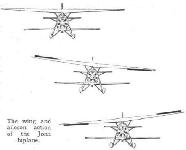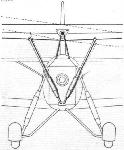
Описание
Страна : Италия
Год : 1936
Two-seat experimental sesquiplane with tilting upper wing
Flight, October 1935
A NOVEL TWO-CONTROL AEROPLANE
Italian Design with Upper Wing on Centre Pivot: Ailerons Not Under Control of Pilot: Possible Risk of Un<...>e of Flutter
THERE are many who hold that the aeroplane as we know it to-day suffers from too great complication of controls. To co-ordinate the movements necessary for the simultaneous working of rudder, elevator, and ailerons has been likened to the feat (to many people almost impossible) of rubbing one’s chest with one hand and patting one's head with the other while carrying out a circling movement with one leg. Actually this is, of course, an exaggeration, but it is generally agreed that if it were possible to relieve the pilot of one of the three controls, something worth while would have been achieved.
There is by no means unanimity concerning which of the three controls it would be most logical to suppress, as correspondence in Flight some months ago proved. M. Henri Mignet, in evolving his Pou. argued that the ailerons got the pilot into trouble, and proceeded to suppress them. Others at least as qualified to judge have maintained that the rudder is the "unnatural" control, and that, if one is to go, it should be the rudder. Several aeroplanes recently produced, including the new De. Havilland Hornet Moth, have had their c.g. positions, fin areas, and so forth, so proportioned and located that all ordinary manoeuvres can be carried out without using the rudder at all. To do away with the rudder as a control surface has not, however, been thought advisable, as there are conditions in which rudder control may be very essential. This is most likely to occur during take-off or landing. The machine may be caused to swing, as, for example, by one wheel striking a rut, and the aileron control would not, it is argued, correct the swing without at the same time causing a probably unwanted bank.
A Milan engineer, Alberto Jona, has evolved a scheme which, he claims, gives the aeroplane the desired lateral stability without the necessity of the pilot operating the ailerons. The machine is fitted with ailerons, but they arc worked automatically and not by the pilot.
Briefly explained, the Jona scheme involves pivoting the upper wing of a biplane (or, rather, sesquiplane, the lower wing being of fairly short span) along a longitudinal axis placed parallel with the chord at mid-span, leaving the wing free to rock around this axis. The aileron controls are connected in such a way that, when a wing tip rises, the aileron on that side is raised and the aileron on the opposite side lowered to restore the wing to its symmetrical position with reference to the fuselage.
Actually, the wing is not entirely free to rock around its fore-and-aft axis. To stop undue exuberance on the part of the wing tips in their movements up and down, the wing is braced diagonally by a pair of struts which take the place of the usual centre-section struts, but which are telescopic and incorporate springs, so that a certain force depending upon the stiffness of the springs, always tends to keep the wing in its symmetrical position.
The action of the Jona wing is as follows: If, for example, the starboard wing tip drops, the link mechanism which connects the aileron control cables to the fixed portion of the machine pulls down the starboard aileron and raises the port aileron. A restoring couple is thus set up which brings the wing back to the central, symmetrical position.
It is realised by the inventor that conditions might arise when this arrangement, by itself, would be inadequate. For instance, he quotes the case when the wing tip drops at or near the stalling angle. The aileron control might not be sufficient to bring the wing tip up, and, to ensure that the power to do so shall always be present, Signor Jona uses, in addition, Handley Page automatic wing-tip leading-edge slots, and "interceptors" linked to the ailerons. It might here be explained that "interceptors" are small strips of material, wood or metal, which normally lie flat against the upper wing surface, or are housed in recesses in the wing. When brought into operation they are either swung upward around a hinge, or raised bodily from their recesses in the wing. Their action is to spoil the lift of the portion of the wing over which they act.
The machine on which the new wing arrangement is being incorporated was built by the P. Magni Aviazione works to the order of the Italian Government, and the intention is that the machine, known as the Jona J.6, shall be exhibited at the Milan Aero Show, which is due to open next Saturday. But few particulars of the machine are available, and no performance figures are released. These, however, are relatively unimportant in comparison with the new wing arrangement. The fuselage is of welded steel tube construction, while the wings are mainly built of wood and are plywood-covered. The gross weight is about 2,000 lb., and the disposable load 715 lb. The span of the pivoted wing is 33 ft. 6 in., and that of the lower wing 22 ft. The total wing area is 197 sq. ft. The engine is a Fiat type A.54 of 140 b.h.p.
Signor Jona intends to have a second machine at the Milan Aero Show. This is a four-seater pusher biplane with a 180-h.p. Fiat A.70 S engine.
Apart from the question of whether the Jona lateral stability arrangement is likely to work in all kinds of manoeuvres, such as steeply banked turns without sideslip, inwards or outwards, one cannot help wondering what will be effect of engine torque. One would imagine that torque reaction will cause the wing to be always slightly tilted from its symmetrical position, and the ailerons set over to counteract this. Whether a sufficiently correct adjustment of all the linkages, spring tensions, and so forth can be secured to bring about a stable condition of settings in all conditions of torque-reaction, whether "engine on" or "engine off," may be open to some slight doubt.
It is also possible to visualise the opportunity which such a wing arrangement may provide for wing flutter of a somewhat unusual kind. What with ailerons geared to a rocking wing dampers introduced in the steadying struts, automatic wing-tip slots and interceptors linked to the ailerons, it is not difficult to imagine that conditions favourable to the setting up of flutter might arise. However, it is understood that provision has been made for locking the rocking upper wing of the Jona J.6 in its central position, and for normal lateral control to be effected by ailerons on the lower wing in case of emergency. The experiment is certainly interesting, and the results of flight tests will be awaited with considerable interest.
Among the advantages of the Jona wing arrangement claimed by the inventor is, somewhat curiously, that for blind flying the two occupants would share the control of the machine between them, so that each would have but one control to look after, one attending to the height of the machine and the other concentrating on accurate course-keeping. It is a little difficult to see the advantage of such a division of duties.
- Flight, October 1935
A NOVEL TWO-CONTROL AEROPLANE
Фотографии
-
Jane's All the World Aircraft 1938 / 03 - All the world's aeroplanes
Four views of the Jona J-6 Sesquiplane, the two middle views showing the tilting upper wing.
-
Flight 1935-10 / Flight
A side elevation ol the Jona J.6 biplane, with its pivoted top wing.
-
Flight 1936-10 / Flight
This diagram shows how the pivoted upper wing of the Jona J.6 automatically operates the ailerons to restore it to the central position.
-
Flight 1935-10 / Flight
The link mechanism which connects the aileron controls to the fixed portions of the aeroplane for automatic aileron operation.
-
Flight 1935-10 / Flight
The pivoted wing is not entirely free to rock around its longitudinal axis, but is restrained by two diagonal telescopic struts.
- Фотографии




